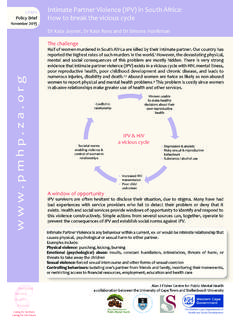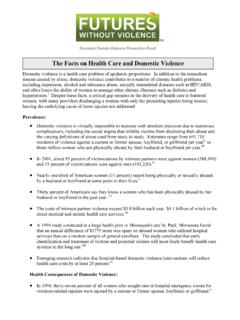Transcription of Workplace Violence Prevention - Centers for Disease ...
1 Workplace Violence Prevention Strategies and Research Needs Report from the Conference Partnering in Workplace Violence Prevention : Translating Research to Practice November 17 19, 2004, Baltimore, Maryland DEPARTMENT OF HEALTH AND HUMAN SERVICES. Centers for Disease Control and Prevention National Institute for Occupational Safety and Health This document is in the public domain and may be freely copied or reprinted. Disclaimer Mention of a company or product does not constitute endorsement by the National Institute for Occupational Safety and Health (NIOSH).
2 In addition, citations to Web sites external to NIOSH. do not constitute NIOSH endorsement of the sponsoring organizations or products. Furthermore, NIOSH is not responsible for the content of these Web sites. The recommendations and opinions expressed in this document are those of individual partici . pants in the conference and may not represent the opinions and recommendations of all members, or of the organizations they represent. Ordering Information To receive documents or other information about occupational safety and health topics, contact NIOSH at NIOSH Publications Dissemination 4676 Columbia Parkway Cincinnati, OH 45226 1998.
3 Telephone: 1 800 35 NIOSH (1 800 356 4674). Fax: 513 533 8573 E-mail: or visit the NIOSH Web site at DHHS (NIOSH) Publication No. 2006 144. September 2006. Safer Healthier People . ii Workplace Violence Foreword Since the 1980s, Violence has been recognized as a leading cause of occupational mortality and mor . bidity. On average, million workers are injured each year, and more than 800 die as a result of Workplace Violence (WPV) [Bureau of Justice Statistics 2001; BLS 2005]. These tragic deaths and injuries stress the need for a proactive and collaborative WPV Prevention effort at the national level.
4 As part of its WPV Research and Prevention Initiative during 2003, the National Institute for Oc . cupational Safety and Health (NIOSH) convened a series of stakeholder meetings that focused on various types of WPV and the industries and occupations at risk. For example, separate meetings addressed domestic Violence in the Workplace , Violence in heath care facilities, Violence in retail settings, and Violence against law enforcement and security professionals. The purpose of these meetings was to bring together subject matter experts from business, academia, government, and labor organizations to discuss current progress, research gaps, and collaborative efforts in address.
5 Ing WPV. One of the recurring discussion points that emerged from the meetings was the need for a national conference on WPV Prevention . In November 2004, NIOSH assembled a diverse group with representatives from various disci . plines and organizations that have a stake in reducing the toll of WPV. This landmark confer . ence Partnering in Workplace Violence Prevention : Translating Research to Practice was held in Baltimore, Maryland, on November 15 17, 2004. The sessions were structured to give participants an opportunity to discuss the current state of national research and Prevention efforts.
6 The intent was to draw out their best professional judgments on (1) identification and implementation of ef . fective Prevention programs and strategies, (2) identification of barriers to Prevention and steps for overcoming them, (3) current research and communication needs, and (4) the advancement of research and Prevention through effective partnerships. This report summarizes discussions that took place during the conference. The report does not include a documented review of either the literature on WPV in general or intervention effective.
7 Ness research in particular. In addition, the authors have consciously avoided adding the NIOSH. perspective to this report or otherwise augmenting its content. We have preferred to represent as accurately as possible the information, ideas, and professional judgments that emerged from the discussions that took place at the Baltimore workshop. In my view, the November conference was very successful. This report provides the following: 1. A useful direction for overcoming current barriers and gaps that impede collaborative research, Prevention , and communication work 2.
8 An emerging collective vision (based on input from participants) of effective WPV pre . vention programs that employers and practitioners can consider now 3. A discussion of the research and partnerships needed to advance WPV Prevention Workplace Violence iii I believe that this report will further raise awareness of this national problem and point the way to increased knowledge about the risks, causes, and Prevention of WPV. In addition, this report will help companies initiate, improve, and evaluate their WPV Prevention efforts.
9 Ultimately, the document will help to accelerate the current downward trends in injuries and deaths from on-the-job as . saults. John Howard, Director, National Institute for Occupational Safety and Health Centers for Disease Control and Prevention iv Workplace Violence Contents Foreword .. iii Abbreviations .. vii Acknowledgments .. viii Conference Planning Committee Members .. ix 1 Introduction .. 1. Scope of Workplace Violence (WPV) .. 1. Background: surveillance, research, and Prevention .. 3. Methods and objectives.
10 7. 2 Barriers and Gaps that Impede WPV Prevention and Strategies to Overcome Them .. 8. Barriers to WPV Prevention practice .. 8. Gaps in WPV Prevention research .. 11. 3 WPV Prevention Programs and Strategies .. 14. Strategies or approaches that may apply to more than one type of WPV .. 14. Strategies specific to Type I (criminal intent) Prevention .. 16. Strategies specific to Type II (customer/client Violence ) Prevention .. 17. Strategies specific to Type III (worker-on-worker) Prevention .. 17. Strategies specific to Type IV (personal relationship Violence ) Prevention .











